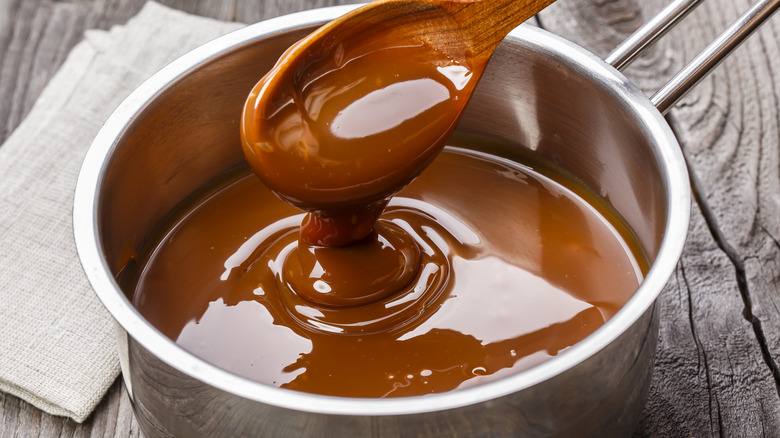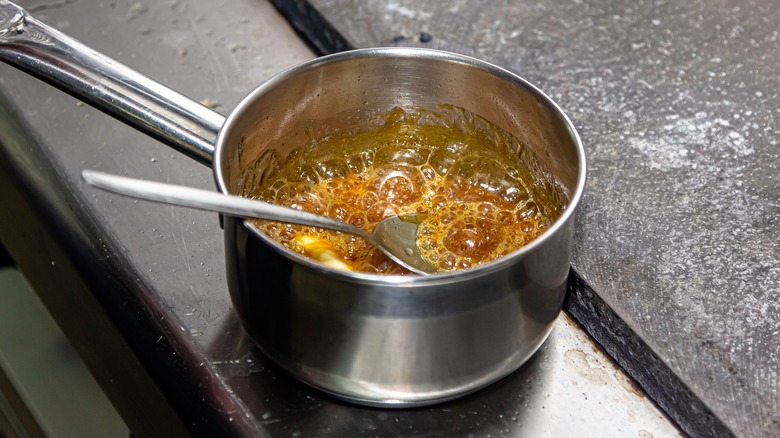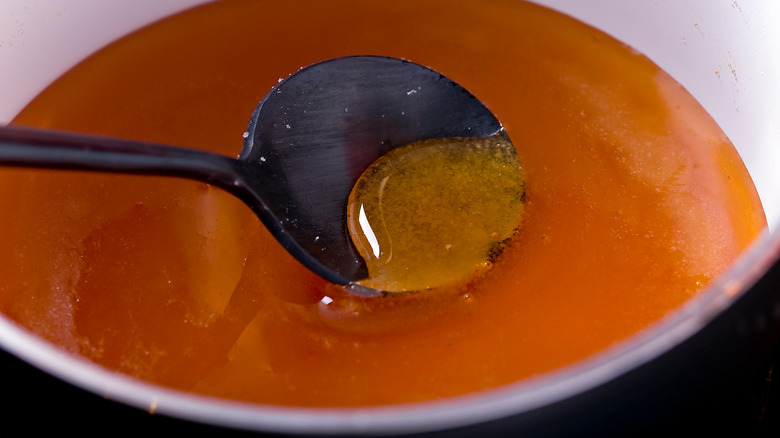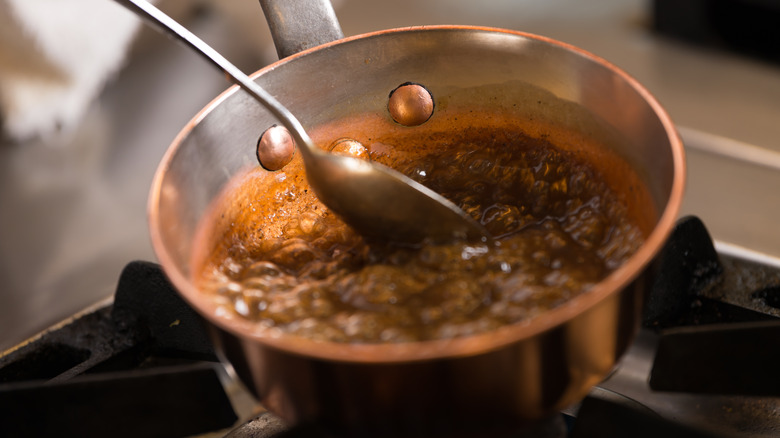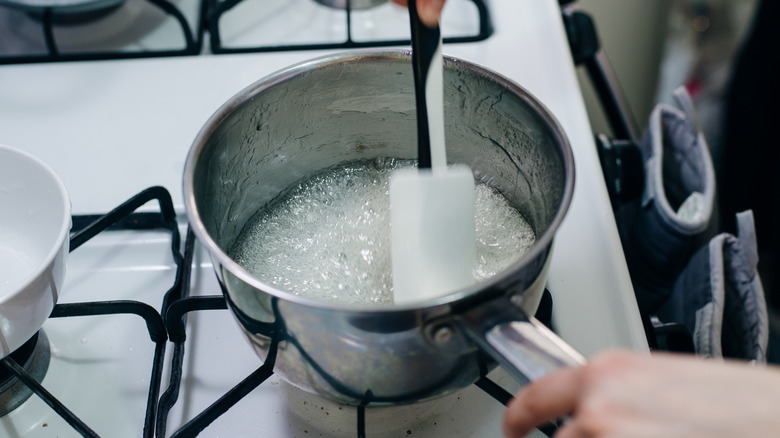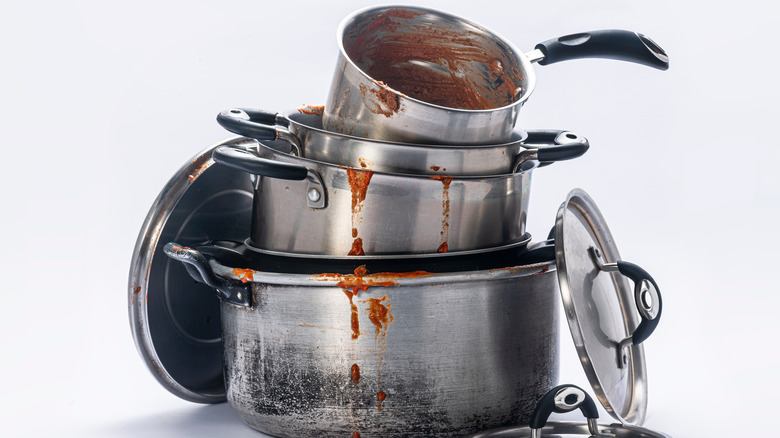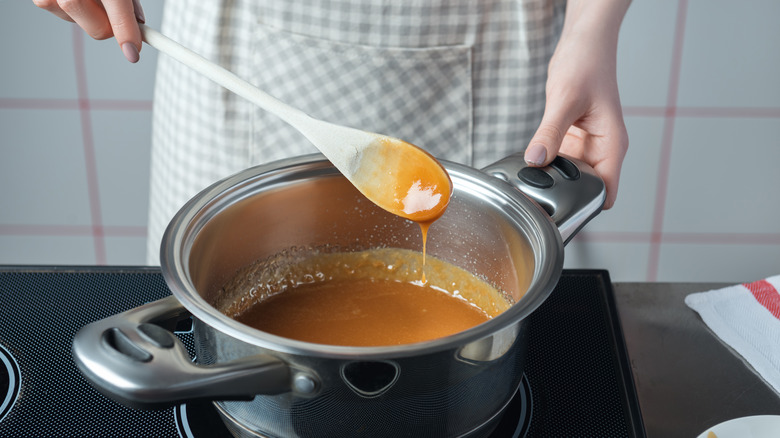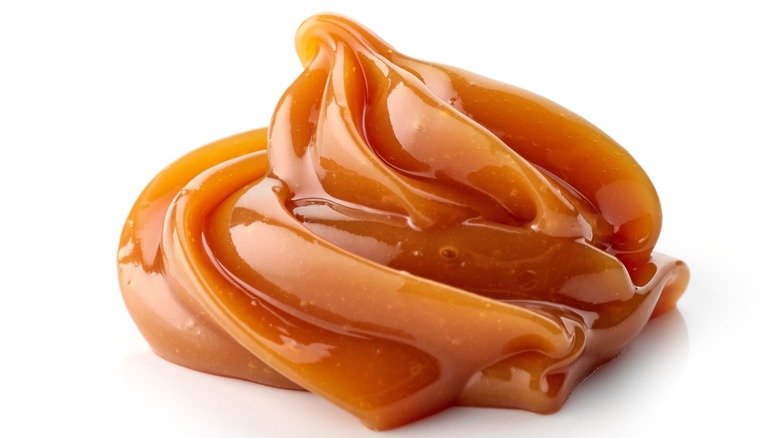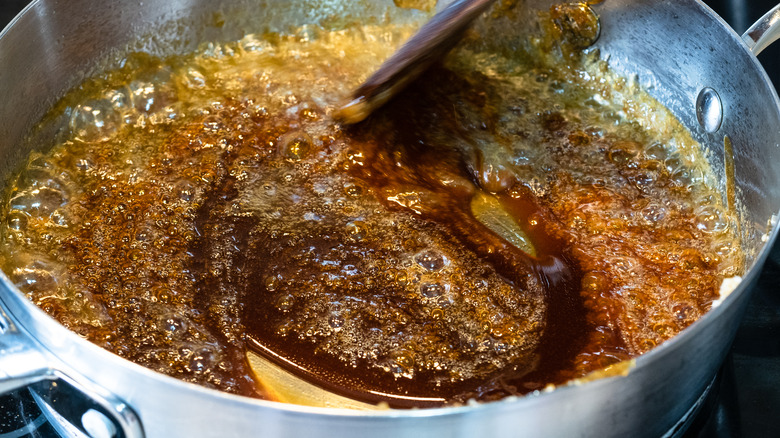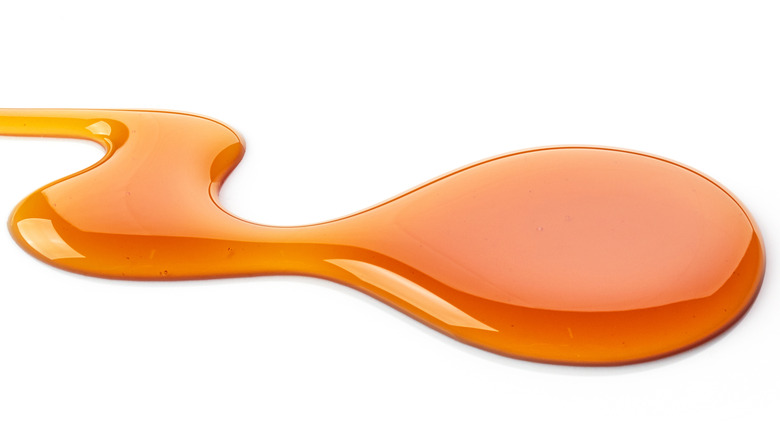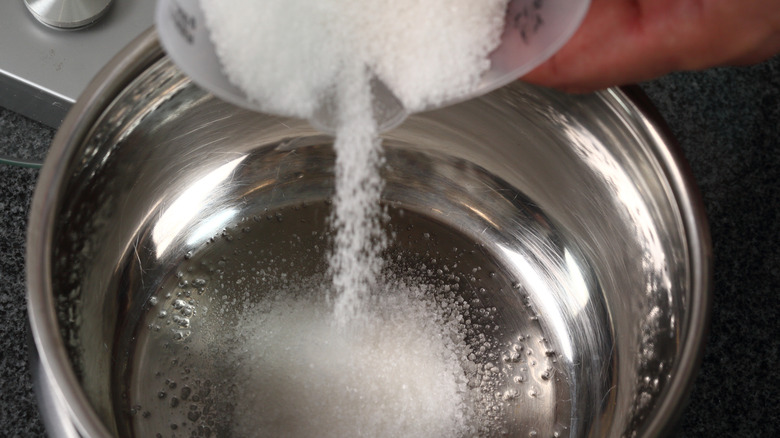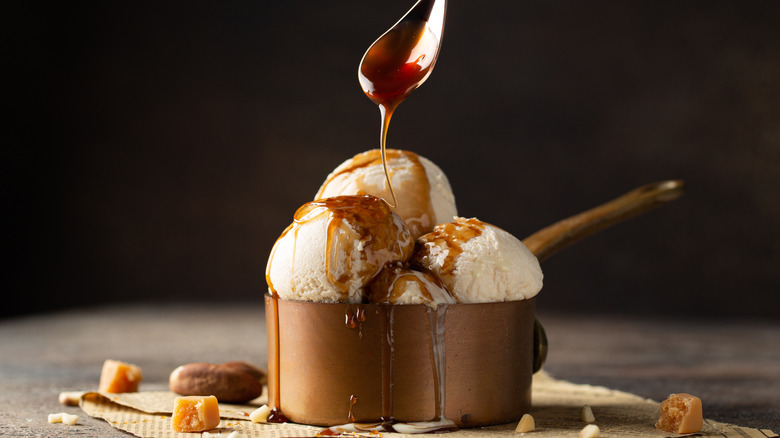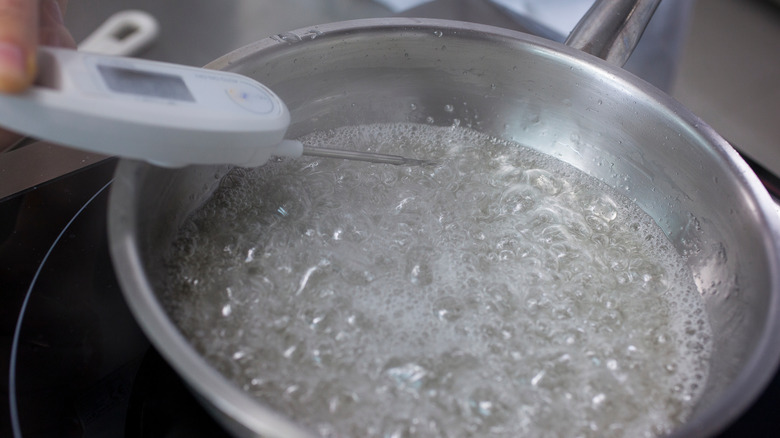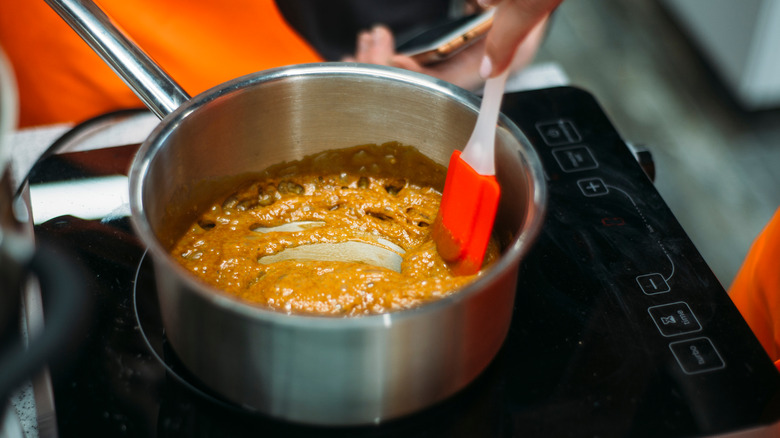13 Mistakes Everyone Makes When Making Caramel Sauce
Caramel sauce is spectacular when it's drizzled on cold, creamy desserts or warm, fruity pies. It's delectable with cakes and chocolate, nutty flavors. And you can even add it to drinks for a swirl of sweet, creamy decadence. Try our copycat Starbucks Caramel Frappuccino for a dreamy sweet coffee blend if you need any convincing.
Our homemade caramel sauce promises that unmistakable rich and creamy taste. The light brown sugar and white sugar dissolve into melted butter with vanilla extract, maple syrup, and heavy cream, elevating the flavor. You can also turn caramel into candies such as fudge and toffee. If you want to keep it as a sauce, then there're specific techniques, timings, and temperatures you'll need to follow. It's not that making caramel sauce is difficult, but diligence and care are needed to achieve that unmistakable smooth caramel gooeyness. Here are 13 mistakes everyone makes when making caramel sauce... and how to avoid them, or fix them, at least.
1. Letting sugar crystalize
Smooth, velvety caramel sauce works, whereas a grainy one doesn't. This gritty consistency is essentially caused by the sugar in the caramel sauce crystallizing. By the time the saucepan reaches a certain temperature, it starts to caramelize, and the sugar that's already dissolved shouldn't reform into crystals. However, if the heat is too intense too soon and the water quickly burns off, then this can easily happen. This can also happen when the sauce is over-stirred before the sugar has melted. Swirling the caramel is better than stirring. And a spoon can cause the sugar to crystalize in the same way that a pan that isn't clean enough can. This is because impurities in metals cause this crystalizing reaction.
Thankfully, there are remedies if the sauce starts to crystallize. Try adding an acidic element to prevent crystals from forming such as cream of tartar, or add a liquid such as corn syrup. If you see crystals up the sides of the pan then brush them off so that they don't just stick there. Creating steam by putting the lid on will also dissolve these crystals, although be mindful to keep an eye on what's happening in the pan. You can also try to simply reheat your sauce on low heat and add a little water. Stir until the sugar has dissolved and the extra liquid has evaporated. Then you should be left with a smooth sauce.
2. Not letting the sugar caramelize
There are plenty of foods you can cook and caramelize such as onions and pineapples. What they all have in common is that they contain sugar. If you heat sugar, then it caramelizes or breaks down, creating a lovely brown color and distinctive taste. The reason why this flavor is so loved is it gives umami a boost. In other words, it's moreish and flavorful. However, if you're heating sugar in a pan to make the caramel sauce, you need the right quantities of sugar and other ingredients, the right heat, and enough time for the sugar to melt and turn brown. A big mistake is to take your pan off the heat before this process has finished.
If your sugar isn't caramelized enough, then it's not going to taste like caramel, though it will have a sweet flavor. Caramelization begins at 320 degrees Fahrenheit, and you need to reach this temperature with the right amount of heat for the right amount of time, using the right pan. Melted sugar is not the same as caramelized sugar. Once the sugar is melted, the liquid will turn a golden color. However, to caramelize it, you want that shade to darken, so you need to keep it on the heat for around another six to eight minutes. Be aware that if you've used brown sugar, the liquid will darken faster than if you've used white sugar.
3. Using the wrong pan
For safety reasons, it's essential that you use the right pan to make a caramel sauce. As you heat and stir the sugar and other ingredients, your sauce is going to froth and bubble. So first of all, it has to be large enough that if there's a little spattering, the hot liquid doesn't leap out of the saucepan. This aside, if you use the wrong pan, your caramel might not turn out so good either.
You might find a saucepan works better than say a frying pan. That way you've got some depth and the sauce is less likely to go sloshing over the sides. It's up to you whether you prefer a non-stick pan or not. While a non-stick pan might be a little easier to clean, the heat could also risk breaking down the protective material. Either way, you want the ingredients to heat up evenly so that caramelization happens as it should. A stainless steel pan conducts heat well and not too quickly. Aluminum isn't advised as it's going to heat up too fast and this might burn your sauce. Likewise, stainless steel-lined copper pans are fine but tin-lined copper pans that can't withstand high temperatures aren't. A thin pan might lead to less than even heating, so choose a heavy-bottomed pan.
4. Using the wrong method
You'll find plenty of different recipes out there to make a caramel sauce. While some might not include dairy, others add milk and cream. You can also add sour cream if you like a little tangy edge to the sweetness. However, it's not just the ingredients that vary. The techniques do too, with two main ways to make the caramel sauce, both creating different flavor intensities.
The dry method involves heating sugar in a pan so that it caramelizes, whereas you add water to the sugar with the wet method. The water enables you to cook the sugar for longer without it burning and this brings out a deeper flavor. However, the dry method isn't at risk of crystallizing.
If you make our outrageously good chocolate, candy, and caramel ice cream sandwich, you'll use the dry method. Once you've swirled around the light brown sugar as it caramelizes, you take it off the heat. That's when you add the butter and the cream. It won't go back on the stovetop again, and in fact, you can help cool it down by putting it into the fridge. If it's already cool, then you can give it an extra cold blast by sticking it in the freezer for a short time.
5. Not cleaning the pan properly
The idea of homemade caramel sounds glorious to eat. However, it's less appealing if you're the one doing the washing up. Scrubbing off stuck-on sugar sounds like hard work. Soaking doesn't always work brilliantly either, especially if you're dealing with what is in effect molten sugar adhering to your saucepan. However, not cleaning the pan properly is a mistake when making caramel sauce. However, three is an easy way to clean up that can hopefully make your caramel-making experience run as smoothly as your homemade sauce. A simple, easy way to clean your caramel pan is also important in case you need to make extra sauce.
Fill your saucepan with water and heat on your stovetop. As the water warms up, it will start to melt any sugar crystals or burnt-on caramel. Keep your pan on a simmer while it cleans and add in your spoon and whatever else needs cleaning. Rinse the pan afterward or leave the water in there until you're ready to clean it. The caramel and sugar won't stick to the pan again.
If you can't get rid of burnt-on food this way, add some baking soda to the pan once you've emptied the water out. See if rubbing the pan with this helps for more stubborn areas. You can always repeat using boiling water again if need be.
6. Making the caramel sauce too thin
Caramel sauce is wonderfully luxurious. That's because it's made with caramelized sugar, butter, and heavy cream. No wonder it's so ridiculously good. That slow pour as the thick sauce flows onto your dish enhances just how mouthwatering it is. What's less decadent is a thin caramel sauce that doesn't have that creamy taste and densely divine texture. You need some substance to your sauce to make certain desserts too, like our salted caramel macarons.
This thinness might happen because you've simply added too much water. Another reason is that you haven't left enough time for the sauce to cool off. Leave it a little longer to see if it thickens. If it's still not thick enough, it might be because you've not cooked your sauce for enough time, so it's just a case of reheating it and burning off some of the liquid. You can also try adding heavy cream to thicken a sauce if your recipe used milk originally. Another option is making a second, thicker sauce and combining this with your original one. Or try stirring in a starch and water paste while your caramel heats up. You can also try adding a teaspoon of cornstarch mixed with a tablespoon of cold water to thicken a cupful of caramel sauce.
7. Making the caramel sauce too thick to pour
While thin caramel sauce doesn't taste indulgent, caramel sauce can also become tacky and toffee-like if it's too thick. Plus, you might struggle to pour your sauce if the consistency is off, leaving the sauce to just fall on your dish in dollops. This isn't what you want if you're making our caramelized bananas, for example. You want the caramel to complement the softness of the fruit and the vanilla ice cream you serve with them.
You want to be able to pour your sauce so that it covers your ice cream or your sundae. However, when it's hot, it's thinner than it's going to be once it's cooled. If it's looking too thick, then you could try adding in a bit of brandy or some other liquor. This will also enhance the flavor. If you don't want to add any alcohol, then some more heavy cream stirred into the sauce should suffice. Being mindful of how caramel thickens as it cools is also a good idea. You might find it easier to thicken thin sauce than the opposite. This is because adding any liquid is going to inevitably change the flavor to some extent.
8. Burning the sauce
Whatever type of sauce you're making, the chances are that burning it is a big mistake. In the case of a caramel sauce, the risk of a burnt result is fairly high if you don't keep an eye on what you're doing. The fact that you're heating sugar, butter, and cream means that timings and temperatures are everything. Look out for the sugar caramelizing and make sure that it doesn't turn from an amber color to a dark brown. You might try cooling your pan quickly once the right temperature has been reached for caramelizing sugar. Do this by placing the pan in cold water without any liquid getting into the pan. If you get your cold butter in quickly, then this will have a cooling effect too, and might prevent the temperature from getting too hot.
Any aftertaste is going to taint any other ingredients you use to make a dessert with caramel sauce. For example, if you want to be creative and make our 5 ingredient caramel turtles, then you'll want the flavor of the pecans and chocolate to shine too. You don't want the caramel to taste anything but creamy and buttery. While some culinary errors are salvageable, burning the caramel sauce really isn't. So, if you do mess up, it'll be best to abandon your burnt offering, soak your pan, and start again.
9. Not cooking at a high enough temperature
It's the caramelization of the sugar — caused by heat — that creates such a wonderfully rich flavor in a caramel sauce. If you don't get the temperature high enough, then it's going to lessen the intensity of the flavor. However, you don't want your sauce to burn, and getting it right can be tricky. A lower heat results in a more sugary taste, which you may want to achieve. However, if you want the overriding taste to be caramel that's not too sweet, then you need to adjust the cooking time or the heat level. Either way, the temperature you're looking for is between 360 and 375 degrees Fahrenheit. Try starting with higher heat and turning it down once the sugar dissolves and changes color.
Aside from a thermometer, remember that the darker the crystalized sugar, the more complex the flavor of the caramel. Of course, if your caramel sauce is just one ingredient in a recipe, then the method and timing of heating will vary. To make our caramel apple turnovers the sauce is made with brown sugar in a pan with apple pieces, butter, and cinnamon, as well as cornstarch. You then bake the caramel sauce filling in the oven in puff pastry.
10. Getting the liquid and sugar ratio wrong
With so few ingredients, it's not exactly rocket science to know the quantities of each ingredient matter. While some recipes add infused cream, butter, or even alcohol, you can also make a dairy-free version with just water and sugar. Great British Chefs suggest using double the amount of caster sugar to water for the best ratio. To keep this balance, you want the sugar to dissolve before all the water has evaporated. Start with half the water and all the sugar. Once the mixture has caramelized, you can then add the rest of the water and whisk so that the caramel sauce comes together.
Some recipes may require some tweaking regarding the amounts of sugar and water. For example, our simple pumpkin caramel sauce has pumpkin puree and spice added. To make this sauce, use three times as much sugar as water. Or, try our sticky-sweet caramel corn with corn syrup and maple syrup instead. Finally, you could try using honey and some sugar to make our easy caramel filling.
11. Not burning the sugar
In most cases, your attention has to be on the color and temperature of your caramel sauce so as not to burn it. However, there are times when not taking the caramelization a little further could be a mistake. If you take the temperature up to 390 degrees Fahrenheit, then much of the sweetness of the sauce will disappear. Instead, there'll be bitterness that comes through in the flavor instead. This can actually be quite appealing, especially if you're using the sauce in savory dishes.
An ecole chocolat, for example, features a burnt caramel sauce that's recommended for drizzling on all types of desserts from brownies to ice cream. To follow this technique, add corn syrup once the granulated cane sugar melts. This actually accelerates caramelization. In many recipes, you add this liquid first or with the sugar. Often, the caramel cools when the cream is added. You don't want the caramel to cool with this burnt version, so heat the cream beforehand and add it to the caramel, carefully, when it's hot. There are telltale signs when you've heated your sugar and corn syrup enough. The caramel will turn a very dark or black color and the foam will be made up of large bubbles.
12. Not testing the temperature if you do not have a thermometer
A handy kitchen gadget if you love making caramel sauce, or even if it's the first time, is a thermometer. You don't need just any type either, but a specific candy thermometer or sugar thermometer as it's also known. But what do you do if you don't have one, but have your heart set on making our salted caramel cake? If you're oblivious to how hot your caramel is, then you're running the risk of ruining it.
One of the best ways to judge temperature without a thermometer is to pour a small amount of the caramel into iced water. How it reacts will tell you a lot about how hot that caramel is. If the caramel is suspended as a thread in the water, then the temperature is around 215 to 230 degrees Fahrenheit. If your sample turns into a squishy ball, then that denotes a reading of around 240 degrees Fahrenheit. If there's some firmness, then add on another five degrees. Once that ball is hard, then the heat may have reached between 250 and 260 degrees Fahrenheit.
13. Forgoing kitchen safety
If you're making our caramel apple popcorn, then you're in for a treat. However, before you chill out with a big bowl in front of a movie, make sure you're putting safety first. This isn't just while you're making the caramel sauce, but also when you're making the popcorn. While this isn't a complex recipe, it's all about timing, like making sure your caramel is ready when your popcorn is. You also need to make sure your oven is hot enough to bake your caramel-covered popcorn. Being organized makes cooking less stressful and that means mishaps are less likely too. Get all your ingredients measured and ready so that you can focus on your sauce without being distracted.
If you add cold cream to hot sugar that's melted, then it's going to react and it could spit out of the pan. Warming the cream can prevent this, as can standing back so that you don't get hot caramel on you. Use protective oven gloves, keep your arms covered up, and don't rush. Take your time when stirring your sauce and be mindful of temperatures and how quickly you're heating your ingredients up. If you do get some hot caramel on you, then immediately rinse the skin that's affected with cold water. Making caramel is enjoyable and easy if you avoid some common mistakes when making it.
